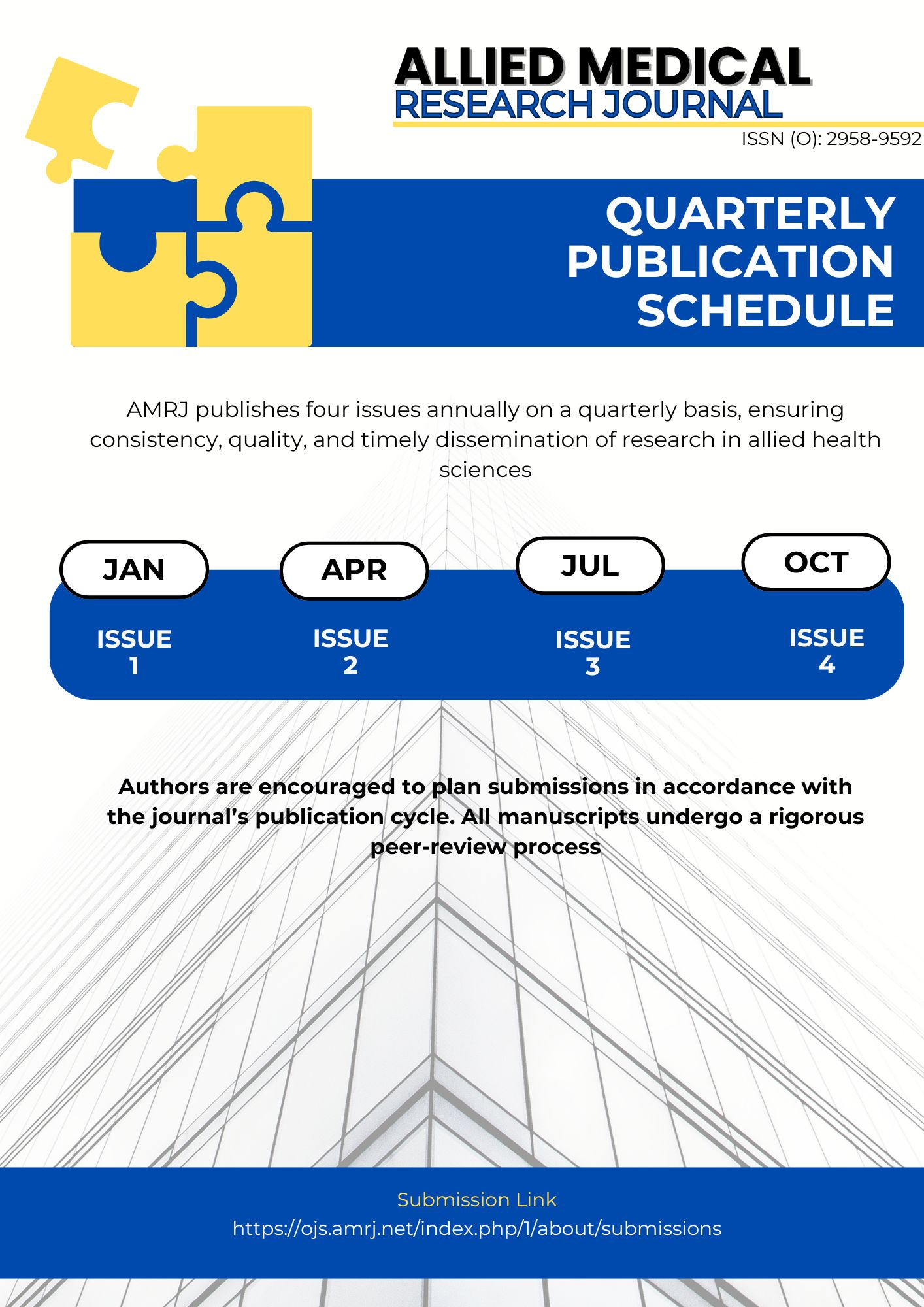A Survey of Aseptic Techniques for Labor Epidurals by Anesthesiologists in Tertiary Care Hospitals of Karachi
Aseptic Techniques for Labor Epidurals by Anesthesiologists
Keywords:
Labor, Epidural, Obstetrics, SterilizationAbstract
Background: This study aimed to investigate the current practices of physicians regarding the essential components of aseptic precautions during labor epidural anesthesia in tertiary care hospitals in Karachi. By understanding the perspectives of anesthesiologists on aseptic techniques, this research seeks to inform improvements in clinical practice and the development of standardized care in this critical aspect of obstetric anesthesia.
Methods: One hundred forty-five anesthesiologists from several Karachi teaching facilities were enrolled in this cross-sectional survey through a convenience sampling technique. Upon their voluntary consent, they were provided with the questionnaire to administer, their demographic information, and preoperative, surgical, and postoperative practices.
Results: A total of 145 anesthesia consultants and specialists consisting of 37.93% female and 62.07% male practicing in Karachi’s tertiary care hospitals were included in this survey. The average age of the participants was 33.50±6.95 years. Most (73%) worked in private institutes, and 27% worked in public. Regarding aseptic preparation, 75.2% of anesthesiologists used pyridine before conducting epidurals, while >85% removed their accessories and followed the protocol of sterilization. Most participants (>50%) used appropriate solutions for sterilization and perceived cleanliness. In comparison, nearly 82% to 89% of respondents agreed that all patients and support personnel in the room needed to wear head and face masks.
Conclusion: The survey highlights the variability in the practice of aseptic technique among anesthesiologists during labor epidural insertion. The findings underscore the need for evidence-based guidelines to standardize procedures and enhance patient safety.
References
Jain A, Mittal A, Sharma S, Deep A. Comparative evaluation of intrathecal dexmedetomidine and fentanyl as an adjuvant for combined spinal–epidural analgesia for labor. Anesthesia Essays and Researches. 2022 Apr 1;16(2):197-202.
Wei C, Gu A, Muthiah A, Fassihi SC, Sculco PK, Nunley RM, Bernstein BA, Liu J, Berger JS. Neuraxial anaesthesia is associated with improved outcomes and reduced postoperative complications in patients undergoing aseptic revision total hip arthroplasty. Hip International. 2022 Mar;32(2):221-30.
Nguyen TP, Kant I, Cartagena A, Kim JH. Drug‐induced aseptic meningitis after an interlaminar lumbar epidural steroid injection. Pain Practice. 2023 Dec 18.
Ojiakor SC, Obidike AB, Okeke KN, Nnamani CP, Obi-Nwosu AL, Egeonu RO, Eleje GU, Ofojebe CJ. Factors associated with demand for epidural analgesia among women in labor at a tertiary hospital in Nnewi, South-East, NigeriaFactors associated with demand for epidural analgesia among women in labor at a tertiary hospital in Nnewi, South-East, Nigeria. Magna Scientia Advanced Research and Reviews. 2021;2(1):008-13.
Deepak D, Kumari A, Mohanty R, Prakash J, Kumar T, Priye S. Effects of epidural analgesia on labor pain and course of labor in primigravid parturients: a prospective non-randomized comparative study. Cureus. 2022 Jun 19;14(6).
Ren J, Wang T, Yang B, Jiang L, Xu L, Geng X, Liu Q. Risk factors and safety analyses for intrapartum fever in pregnant women receiving epidural analgesia during labor. Medical science monitor: international medical journal of experimental and clinical research. 2021;27:e929283-1.
Bishop DG, Lucas DN. If it isn’t written down, then it didn’t happen: documentation in obstetric anaesthesia. Southern African Journal of Anaesthesia and Analgesia. 2022 Sep 1;28(4):124-30.
Yildirim SA, Sarikaya ZT, Ulugol H, Toraman F. Neuraxial anesthesia in a parturient with common variable immunodeficiency: a case report. International Journal of Obstetric Anesthesia. 2022 Feb 1;49:103219.
Al-Husban N, Elmuhtaseb MS, Al-Husban H, Nabhan M, Abuhalaweh H, Alkhatib YM, Yousef M, Aloran B, Elyyan Y, Alghazo A. Anesthesia for cesarean section: retrospective comparative study. International Journal of Women's Health. 2021 Feb 2:141-52.
Jain A, Mittal A, Sharma S, Deep A. Comparative evaluation of intrathecal dexmedetomidine and fentanyl as an adjuvant for combined spinal–epidural analgesia for labor. Anesthesia Essays and Researches. 2022 Apr 1;16(2):197-202.
Humaddim HK, Flaifel HA, Nazair AK. Comparative Study between Epidural Analgesia, Intrathecal Analgesia and Intravenous Remifentanil Analgesia in Management of Labor Pain. Advance Research Journal of Medical and Clinical Science. 2022 Nov 18;8(11):1031-9.
Nguyen TP, Kant I, Cartagena A, Kim JH. Drug‐induced aseptic meningitis after an interlaminar lumbar epidural steroid injection. Pain Practice. 2023 Dec 18.
Lotffy ME, Radi AA, Soliman NM, Gaballah KM, Youssef AR. Low Dose Combined Spinal-Epidural Anesthesia Versus Conventional Epidural Anesthesia for Elective Cesarean Section in Severe Preeclampsia.
Klemt C, Yeo I, Harvey M, Burns JC, Melnic C, Uzosike AC, Kwon YM. The use of artificial intelligence for the prediction of periprosthetic joint infection following aseptic revision total knee arthroplasty. The Journal of Knee Surgery. 2024 Jan;37(02):158-66.
Syed AB, Kapote DS. A study to determine the effects of epidural analgesia in labour and to assess its maternal and neonatal outcome. International Journal of Reproduction, Contraception, Obstetrics and Gynecology. 2023 Dec 1;12(12):3491-8.
Tuohey BH, Shelton CL, Dieleman S, McGain F. Time to re-evaluate the routine use of sterile gowns in neuraxial anaesthesia. Anaesthesia and Intensive Care. 2023 Nov 25:0310057X231210314.
Yildirim SA, Sarikaya ZT, Ulugol H, Toraman F. Neuraxial anesthesia in a parturient with common variable immunodeficiency: a case report. International Journal of Obstetric Anesthesia. 2022 Feb 1;49:103219.

Downloads
Published
Issue
Section
License
Copyright (c) 2024 Muhammad Farhan Hasan, Tarique Aziz Qureshi, Adeel-ur-Rehman, Kashif Naeem, Mahendar Wanwari, Hasham Ahmed

This work is licensed under a Creative Commons Attribution-NonCommercial 4.0 International License.








